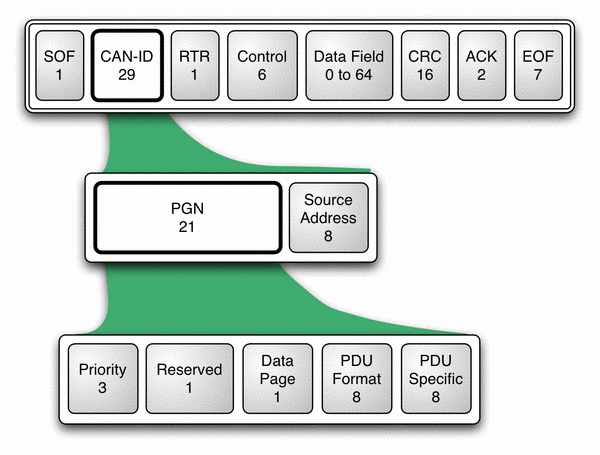In comparison to CANopen, which is using the 11-bit identifier (CAN-ID) J1939 is using the 29-bit CAN-ID. The CAN-ID in J1939 consists of a parameter group number (PGN) and a source address (see Figure 1). A parameter group (PG) is assembled of various parameters defined in the J1939 series, such as vehicle speed, oil temperature, etc. Thus, a PGN identifies the content of the data field.
The priority field indicates the priority of the message, where ‘0’ is the highest priority and ‘7’ the lowest. The data page field is supposed to be set to ‘1’ in the future, if no more free numbers are left to be assigned to new PGNs. If the value of the field ‘PDU format’ is between 00h and F0h, the field ‘PDU specific’ has to be interpreted as destination address. This is used for peer-to-peer communication between two devices. If the value of the field ‘PDU Format’ is greater than F0h, ‘PDU specific’ is interpreted as a so-called ‘group extension’. The PGNs are sent according to the producer/consumer model (broadcast). The source address has to be unique for every device in the network and may be achieved by participating the address claiming procedure.
The priority field indicates the priority of the message, where ‘0’ is the highest priority and ‘7’ the lowest. The data page field is supposed to be set to ‘1’ in the future, if no more free numbers are left to be assigned to new PGNs. If the value of the field ‘PDU format’ is between 00h and F0h, the field ‘PDU specific’ has to be interpreted as destination address. This is used for peer-to-peer communication between two devices. If the value of the field ‘PDU Format’ is greater than F0h, ‘PDU specific’ is interpreted as a so-called ‘group extension’. The PGNs are sent according to the producer/consumer model (broadcast). The source address has to be unique for every device in the network and may be achieved by participating the address claiming procedure.


 RSS Feed
RSS Feed
